活動(dòng)標(biāo)題
- Latest developments on 'Green Olympics'
活動(dòng)描述
- At a press conference on July 3, officials from the Beijing Water Authority, the General Office of Capital Forestation Commission, and the Beijing Municipal Environmental Protection Bureau brief international media on the progress of the 'Green Olympics'. China.org.cn presents live coverage of the press conference.
文字內(nèi)容:
- Li Zhanjun:
Sorry for the delay, technological problem in the Olympic Forest park. Today we have with us Mr. Bi Xiaogang, deputy director general of Beijing Water Authority, Ms. Wang Sumei, deputy director of the Beijing Municipal Forestry and Parks Bureau; and Mr. Wang Xiaoming, deputy secretary-general of the Beijing Municipal Government. First of all I'd like to let Mr. Bi Xiaogang speak.
2008-07-03 16:35:02
- Bi Xiaogang:
Ladies and gentlemen, good afternoon. I know that you've just returned from the Olympic park. I know it's quite hot today and I thank you for your time and attention. I would like to take this opportunity to talk about the water and park services in Beijing. We have fulfilled our Olympic commitment one year ahead of schedule. In this procedure we have also benefited the local citizens. Now I would like to give you a few comments.
2008-07-03 16:38:50
- Bi Xiaogang:
Successful, measurable steps have been taken to promote the concepts of "Green Olympics" since Beijing's successful bidding for the Olympic Games in 2001.
The Beijing Organizing Committee for the Games of the XXIX Olympiad (BOCOG) has worked diligently with civic leaders to strengthened water source conservation, sewage treatment and reuse of renewable water, and made greater efforts for environmental improvement and realignment of riverways.
These tangible results have resulted in the following on-going programs:
2008-07-03 16:41:58
- Bi Xiaogang:
Water source conservation in mountainous areas
The Beijing (Beijing Water Authority) has developed watershed conservation planning in combination with the actual situations. This includes:? Demarcation of watershed conservation areas which cover more than 6,000 square kilometers has been completed.
? Protection for urban reserve watershed areas has been strengthened to ensure the safety of urban water supply;
? Distributed watershed places in rural areas have been protected to ensure the safety of drinking water available for farmers.
Construction of the ecological and clean-type small drainage areas has been comprehensively promoted to protect drinking water sources.
2008-07-03 16:43:03
- Bi Xiaogang:
In mountainous areas, we have sped up the construction of the small clean drainage areas and have built three defensive lines:
? Ecological Restoration
? Ecological Regulation and
? Ecological ProtectionEcological Restoration refers to combining natural restoration and engineering measures to guide the relocation of farmers, close mountain passes and facilitate afforestation in high mountains and steep slopes; the self-repair capacity of the nature and restore the ecological environment and conserve water sources.
2008-07-03 16:45:48
- Bi Xiaogang:
Ecological Regulation refers to synchronized regulation for rural sewage, refuses, toilets, riverways and environment within drainage areas. Sewage pipelines and treatment facilities have been built by villages to recycling renewable water for agricultural irrigation, toilet flushing and environmental protection. In the past three years, one-third of villages in the water source reserve zones have completed sewage treatment and rural toilet transformation projects. Refuse collection facilities have been constructed and closed dustbins have been deployed clean up the environment.
In water source reserve zones, rural areas concentrate refuse collection and processing.Ecological Protection refers to regulation for water sources and riverways within drainage areas from the perspective of ecological protection, which aims to cure sewage running freely into rivers.
2008-07-03 16:47:07
- Bi Xiaogang:
Steps have included freezing up rivers and cultivating grasses as well as developing wind breaks and sand fixation. Taking advantage of rainwater and flood, water conservation and safe flood control have been also integrated. Sixty ecological and clean-type small drainage areas have been completed.
Controlled areas for water and soil loss totaled more than 1,800 square kilometers.
As a result of the above measures, water quality standard of Miyun Reservoir has maintained Class Ⅱ.
2008-07-03 16:49:29
- Bi Xiaogang:
Water-saving management
Water saving is a major strategy of water affairs in Beijing. Laws and regulations, administrative measures, economic measures, technology, engineering and other measures are now in place.
2008-07-03 16:51:02
- Bi Xiaogang:
Measurement management for all agricultural water
Comprehensive management for agricultural water has been launched with 26,300 agricultural motor-pumped wells dug and installed with water meters and input into a computer system to monitor the output.
Measurement of agricultural water has promoted the construction of water-saving farmlands which have been established annually by 300,000 mu with water-saving irrigation up to 88 percent; precise irrigation, drip irrigation and micro-irrigation have developed on a large scale.In 2007, new agricultural water has been remarkably cut from the previous 2 billion to 1 billion cube meters.
2008-07-03 16:53:43
- Bi Xiaogang:
Restrictions upon sectors with high water consumption
Beijing says no to the market access of high water-consuming industries.
Small-scale cement making, small-scale paper making and other 25 kinds of traditional industries have been removed from the city with 170 enterprises characterized by high water consumption and high pollution, such as the Shougang Group and coking plants, have been relocated, closed down or suspended.
The relocation of Shougang Group is saving 40 million cubic meters of water.
Water-saving technological transformation of enterprises has been furthered, which has harvested the fruits of annual 30 brand-new projects. With a water-saving industrial system and industrial water consumption has seen negative growth for eight consecutive years in the city.
The annual completion of 30 water-saving technological transformations has been achieved and the water reuse rate of scale industry has reached up to 93 percent.
2008-07-03 16:55:08
- Bi Xiaogang:
Implementing scalar water prices
Quota management for water consumption has been strictly carried out. Water consumption over the quota subjects to progressive increase of water price.
Real-time monitoring has been launched for major water-consuming entities which use 100,000 cubic meters of water annually. Progressive increase charges have been strictly imposed upon water consumption over the quota.
A number of water-saving advanced models have emerged. At the Yizhuang Industrial Park, many enterprises have completed the transformation of water-saving technologies and water-saving devices are used with 100 percent popularization in public places. Popularization proportion of urban households has reached 85%.
2008-07-03 16:57:38
- Bi Xiaogang:
Speed up construction of sewage treatment plants
By year 2000, Beijing has averaged one new sewage treatment plant opening per year, while construction of supporting pipeline network is ongoing.
According to river distribution of Qinghe River, Liangshui River, Tonghui River, Bahe River and other polluted riverways as well as natural terrain, sewage pipeline system, wastewater reuse and other factors and with a view to the respective integrations of large, small- and medium-sized enterprises / upstream and downstream industries, 14 sewage treatment plants will be constructed in Beijing which can handle 2.68 million cubic meters daily.
Nine sewage treatment plants have been built in Gaobeidian, Fangzhuang, Jiuxianqiao, Beixiao River Phase I, Qinghe River, Wujia Village, Xiaojia River, Lugou Bridge and Xiaohongmen, with a total handling capacity of 2.5 million cubic meters daily.
2008-07-03 16:59:42
- Bi Xiaogang:
In 2007, treatment on urban sewage of 800 million cubic meters has been achieved, with sewage treatment rate up to 92%. The daily urban sewage treatment capacity has reached 2.91 million tons per day. In 2007, the annual urban sewage treatment volume totaled nearly 800 million cubic meters, with sewage treatment rate of over 90 percent.
As a result, Beijing has honored its commitment to the Olympic Games one year ahead of schedule.
2008-07-03 17:01:07
- Bi Xiaogang:
Reaching goal of 50% reuse of renewable water
As a new water source, renewable water has been developed and utilized in Beijing, and has emerged as a main water source for agricultural irrigation, landscape water of rivers and lakes and industrial cooling.
In 2007, the city consumed 480 million cubic meters of renewable water, i.e., the amount of renewable water accounted for 10% of water consumption in Beijing. In 2008, 600 million cubic meters of renewable water will be consumed, reaching 17 percent of the city's water consumption.
Thus, Beijing's promised goal of 50% reuse of renewable water has been achieved.
From agricultural perspective, the newly established Daxing Renewable Water Irrigation Zone covers 200,000 mu in 2006 and 2007; Tongzhou Renewable Water Irrigation Zone, covers 260,000 mu and the annual consumption of renewable water has reached 230 million cubic meters.
2008-07-03 17:03:35
- Bi Xiaogang:
From an industrial perspective the Recycled Water (grey water) diversion Project to the West from Six Factories completed in 2007, which delivers the daily supply of 80,000 cubic meters of water to Gaojing Power Plant and Shijingshan Power Plant, with 30 million cubic meters available annually. Every year, 20 million cubic meters of water is used for urban greening and municipal administration and 60 million cubic meters of water is used for renewing the water in city parks, rivers and lakes.
Six recycled water waterworks have been built in the city, with a daily production capacity of 370,000 cubic meters. 380-km water pipelines are now under construction.
The application of film processing technology guarantees the quality and security of recycled water and provides technical support for broadening utilization.
2008-07-03 17:05:23
- Bi Xiaogang:
Building-up natural ecosystem of riverways
Beijing intersects with major rivers with the total length of 520 kilometers. Previously, part of this water body was black because of sewage dumped directly into rivers. The poor quality of this river water was a serious issue for the city.
The water-treatment process of water systems such as Zhuanhe River, North Moat, Qinghe River and Qingyang River has changed the traditional way of river regulation.
Riverways characterized by bend and widening to natural ecological harmony between human and water have been built. Natural ecological earth and stone have been adopted for river and lake beds.
2008-07-03 17:07:52
- Bi Xiaogang:
Reed, leaf of cattail, lotus and other 60 kinds of aquatic plants now grow well along the riverways. More than 10 species of aquatic animals, such as shrimps and fishes, have been released with more than 50 tons of aquatic animals returning to water every year.
Ecological restoration technology has also created conditions for the use of recycled water in rivers and lakes. In the riverways (which have been regulated) researchers of Beijing Water Authority have made a series of biological and physical measures to maintain water quality and avoid the occurrence of plankton bloom.
In diversion canal of Yongding River, South Moat and Kunyu River, landscape ecology floating floors have been used to cultivate hyacinth, biological girds have been installed and biological measures have been taken, such as feeding fish and clearing aquatic weeds.
2008-07-03 17:09:20
- Bi Xiaogang:
In Shichahai and Houhai, algae collection equipments have been installed. In the lake behind the Beijing Exhibition Center and other water areas, fish fry has been bred to lower the density of algae cells and inhibit the growth and reproduction of algae.
Additional installation of water-lifting pumps has been completed in Beihai, Tongzi River and other water areas. As a result of these effective measures, the quality of urban rivers and lakes has been maintained, the occurrence of plankton bloom has been curbed and the sound water environment has been preserved.
2008-07-03 17:11:48
- Bi Xiaogang:
Ecological construction of the Olympic Forest Park
For the purpose of building ecological environment of water landscape in the Olympic Forest Park, highly-efficient water saving, water recycling and reuse of grey water is a high priority. Water-saving systems, system of renewable water reuse, water utilization system and water cycle purification system have been set up, which fully embodies the concept of the Green Olympics.
2008-07-03 17:13:14
- Bi Xiaogang:
Water supply & water saving
The Olympic Forest Park has been designed to use a daily water supply quantity of 280,000 cubic meters, which is in the charge of No. 9 Waterworks Factory, more than 40 km of water pipes have been laid. Newly-built Olympic venues have been equipped with a kind of two-way water supply device. Water quality now reaches China's Sanitary Standard for Drinking Water and all of the 106 measurement indices meet the requirements up to grade. In such venues and public areas, drinking water facilities and water-saving devices up to high-standard water quality have been installed.
2008-07-03 17:15:48
- Bi Xiaogang:
Rainwater utilization
The period of the Olympic Games comes during the peak flood season.
In order to make sure the security of Games-period, drainage of the Olympic central area has been designed according to the standard which can withstand the largest flood that strikes Beijing once every five years and water system drainage has been designed according to the standard which can withstand the largest flood once in 50 years.
Taking precautions to manage the largest flood once in 50 years, a "super-standard" flood control emergency scheduling program has been developed.
2008-07-03 17:17:16
- Bi Xiaogang:
Beijing has made full use of rainwater resources and the flood discharge pressure has been greatly reduced with the aid of rainwater/floodwater collection facilities. In the Olympic central area, 26 underground rainwater collecting tanks have been built; permeable pavement area has totaled 250,000 square meters; the concave-downward greenbelt has been all completed as greening space.
The Olympic Forest Park in the north part covers 454 hectares of greenbelt, accounting for 67 percent of the total; central area covers 48 hectares. Concave greenbelt is 5-10 cm lower than the surrounding roads or the square, so direct rainwater infiltration is available. By means of collection and storage, rainwater reuse rate of the Olympic Forest Park has reached 70 percent, and largest flood once in 20 years can be impounded in the Olympic Lake. 1.05 million cubic meters of rainfall can be recycled annually.
2008-07-03 17:19:56
- Bi Xiaogang:
Recycling system
The Olympic Forest Park is designed with a drainage capacity of 25,600 cubic meters of sewage water which all enters into the Beixiao River Sewage Treatment Plant. After treatment, such recycled water will return for toilet-flushing, greening and water environment. In the Olympic Forest Park, plant irrigation has utilized renewable water, rainwater and floodwater reaching 100 percent recycling.
The Water system in the Olympic Forest Park is the largest environmental water system with recycled water as supplementary water source. Olympic Lake is filled with high-standard recycled water with supplemented surface water.
2008-07-03 17:21:20
- Bi Xiaogang:
The refilling recycled water is purified by wetland first and then re-enters Olympic Lake.
Recycling process includes the high-quality renewable water-purification through wetlands... then flowing into the lake region... re-flowing into the wetlands... and then re-entering into the lake region, thus creating a reciprocating movement of the water flow cycle.
2008-07-03 17:23:49
- Wang Sumei:
In 2001 when bidding for the Olympic Games, Beijing made a commitment to seven greening indexes, including:
? citywide forest coverage rate of 50%,
? mountainous forest coverage rate of 70%,
? green belts along the two sides of "five rivers and ten roads" claiming a total area of 23,000 hectares
? green shelters within urban areas claiming a total area of 12,000 hectares
? preliminary creation of three green ecological belts
? the urban green coverage rate of over 40% and
? the natural reserve accounting for no less than 8% of citywide land area.
2008-07-03 17:25:51
- Wang Sumei:
By 2007, Beijing had fulfilled all its promises for seven greening indexes of the Olympic Games, namely,
? citywide forest coverage rate of 51.6%
? mountainous forest coverage rate of 70.49%
? green belts along the two sides of "five rivers and ten roads" claiming a total area of 25,000 hectares,
? green shelters within urban areas claiming a total area of 12,600 hectares
? preliminary creation of three green ecological belts, the green coverage rate of 43% in the downtown area of Beijing, and
? natural reserve accounting for no less than 8.18% of citywide land area.
2008-07-03 17:27:09
- Wang Sumei:
In the 1950's, Beijing had a poor environment, with a forest cover of only 1.3%.
The Beijing Municipal Government and residents attach great importance to tree planting and environmental improvement. Since the 1950s, sustained efforts have been made in ecological rehabilitation and protection.
The environment in Beijing has been improved and rehabilitated due to long-term efforts in tree planting and mountain closure. Currently, the citywide forest coverage rate and green coverage rate has reached 51.6% and 43% and the green spaces and public green lawns per capita have totaled 48 m2 and 12.6 m2 respectively.
2008-07-03 17:28:33
- Wang Sumei:
Since Beijing won the bid for the Games of the XXIX Olympiad, Beijing residents' enthusiasm for urban forestry and environment beautification has been greatly enhanced. It is the common objective of Beijing residents to "make joint efforts in hosting a Green Olympic Games and build a green homeland."
Tree planting and environment beautification campaigns have been launched in and around Beijing. For seven years, Beijing, motivated by the concept of "Green Olympics", has arranged the work around the goal of "Hosting Green Olympics and Constructing Ecological City" and boosted on a full scale construction of Olympic forestation, urban forestation and three green ecological shelters.
2008-07-03 17:30:01
- Wang Sumei:
Conducting Olympic forestation
A total of 160 Olympic greening projects for 31 Olympic competition venues, 45 Olympic training venues, the connecting lines for Olympic roads, the Olympic Forest Park and the Olympic Green have proceeded well for the Olympic Games, with a total area of 1,026 hectares now green with 370,000 arbors, 2.1 million shrubs and 460-odd hectares of vegetation planted. This massive construction has been going year round while ensuring the quality of counter-season construction.
During the Olympic Games, Beijing will beautify the main streets and small lanes of the Olympic City with hundreds and thousands of flowers, greeting the guests from every corner of the globe with a world of green plants and sea of flowers.
2008-07-03 17:32:50
- Wang Sumei:
Improving the urban forestry
The Beijing Municipal Government has taken into consideration the urban natural conditions and the residents' demands for greenery in their lives and developed construction projects of "green spaces within 500 meters away from homes" in the downtown areas and requires each district develop 1-2 large-scale green land plots annually.
Open spaces have been developed into small green parks so that residents can have access to parks and green spaces 500 meters away from their homes. Additionally, various approaches have been adopted to create more green for downtown areas, including greening on roofs, walls and overpasses, and developing green-covered parking lots.
2008-07-03 17:34:16
- Wang Sumei:
From 2001 to 2007, the green land area in Beijing
? rose by 10,000 hectares
? trees increased by 22.71 million and
? lawn area grew by 46.53 million m2which greatly improved the ecological environment in the city proper by sequestrating 211,000 tons of carbon dioxide.
2008-07-03 17:36:06
- Wang Sumei:
Creating three green shelters
In 2001, during its bid for the 2008 Olympic Games, Beijing made a commitment that three green ecological shelters including the "urban green separating area, plain and mountainous area" would be established in and around Beijing.
According to the Master Urban Planning of Beijing efforts have been pumped into the construction of ecological shelters around Beijing so that the ecological environment across the city has been significantly improved.
Beijing has demonstrated the ecological landscapes of green mountains embracing the city, forests surrounding the city proper and green pastoral sceneries in the suburban area.
2008-07-03 17:38:31
- Wang Sumei:
In the urban green separating area, a 12,600 hectares greening shelterbelt has been established, which creates the landscape of forest surrounding city. In 2007, the construction project of "suburban park ring" was launched in the urban green separating area so as to improve and restructure the green spaces within the separating area and build more suburban parks for the residents' relaxation and entertainment.
More than 100 suburban parks will be constructed, and 15 parks were completed in 2007 and have been opened to the public since May 2008.
On the plain, the ecological protective forests including the "five-river and ten-road" green corridor with a total length of over 1,000 km and a greening area of 25,000 hectares and the farmland shelterbelt network have been established.
2008-07-03 17:40:03
- Wang Sumei:
The construction of "five-river and ten-road" green corridor involves 15 dense and magnificent green corridors, namely the 30m to 200m-long green belts along the two sides of five rivers and 10 roads. To date, the ecological shelter on the plain, which depends on the green corridor as a framework and achieves the combination of dot, line, plane, belt, network and plot, has been created.
In mountainous areas, great efforts have been made to manage wind and sand sources in Beijing and Tianjin, conduct the ecological rehabilitation of deserted mines, build the protective forests for water source, close hills for natural regeneration, create the forests by explosion, tend young and middle-aged forests, rebuild the low-efficiency forests and construct the natural reserve.
2008-07-03 17:42:59
- Wang Sumei:
Thanks to these ecological construction projects, 95% of the barren mountains have been turned green; the total forest reserve of mountainous area has been increased; the forest green coverage rate has exceeded 70%; the natural reserve has constituted 8.18% of the total land area in Beijing, creating the mountainous green ecological shelter around Beijing.
2008-07-03 17:44:33
- Wang Sumei:
Building the green homeland
Masses of people actively plant trees and protecting the green lands has developed into a good social concept in Beijing.
China's Tree-planting Day falls on each March 12 and the first off-day in April each year is the Tree-planting Day of Beijing.
On the annual Tree-planting Day in Beijing, Party and State leaders take the lead in taking part in the Voluntary Tree-planting Campaign, which greatly encourages all walks of life to take initiatives to get involved in greening activities.
Leaders from the National People's Congress and the National People's Political Consultative Committee, the generals, officers and soldiers from PLA and armed police, as well as the ministers and officials from the central government organs participate in the voluntary tree-planting activities.
2008-07-03 17:46:00
- Wang Sumei:
Millions of residents go to the suburbs each year to turn barren hills green. Some 168 million trees have been planted by local residents since the Voluntary Tree-planting Campaign was initiated in 1981. Many citizens consider it an honor to adopt one tree or a plot of green land.
By 2007, Beijing citizens had built and adopted 146 plots of green land with a total area of 357 hectares and adopted more than 44,000 trees.
Local residents are also active in various greening and environment beautification projects. By the end of 2007, 10 landscape satellite cities, 46 landscape towns, 4,951 garden-like institutions, three national model greening cities and two national model greening counties had been established across Beijing.
2008-07-03 17:48:33
- Wang Sumei:
A total of 463 institutions in the city proper have worked together with 277 villages in carrying out the "Making Efforts Hand in Hand for Building New Countryside" activity to help each other in greening endeavors so as to make the rural areas greener and more beautiful.
Farmers in mountainous areas take an active part in the forest protection work with some 46,000 people trained to protect the ecological forests and are responsible for the protection and management of forests and green lands.
The greening undertaking in Beijing has also received assistance from the international community. Seventeen forestry cooperation projects have been implemented jointly with 11 countries (including Germany, Japan, South Korea and Malaysia) and some international organizations (including World Wildlife Fund).
2008-07-03 17:51:56
圖片內(nèi)容:
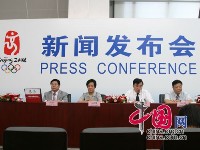 The press conference location
The press conference location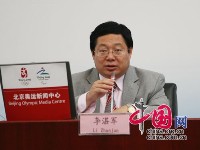 Li Zhanjun, host of the press conference
Li Zhanjun, host of the press conference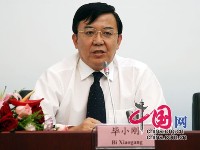 Bi Xiaogang, deputy director of Beijing Water Authority
Bi Xiaogang, deputy director of Beijing Water Authority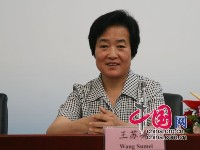 Wang Sumei, deputy director of the Beijing Municipal Forestry and Parks Bureau
Wang Sumei, deputy director of the Beijing Municipal Forestry and Parks Bureau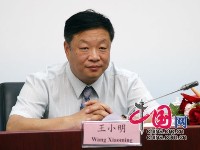 Wang Xiaoming, deputy secretary-general of the Beijing Municipal Government
Wang Xiaoming, deputy secretary-general of the Beijing Municipal Government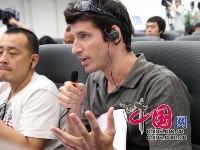 A Reuters journalist is asking questions
A Reuters journalist is asking questions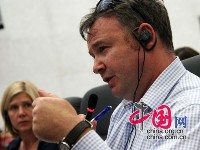 A reporter from South China Morning Post asks a question.
A reporter from South China Morning Post asks a question.

